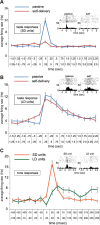Distinct subtypes of basolateral amygdala taste neurons reflect palatability and reward
- PMID: 19244523
- PMCID: PMC2668607
- DOI: 10.1523/JNEUROSCI.3898-08.2009
Distinct subtypes of basolateral amygdala taste neurons reflect palatability and reward
Abstract
The amygdala processes multiple, dissociable properties of sensory stimuli. Given its central location within a dense network of reciprocally connected regions, it is reasonable to expect that basolateral amygdala (BLA) neurons should produce a rich repertoire of dynamical responses to taste stimuli. Here, we examined single BLA neuron taste responses in awake rats and report the existence of two distinct subgroups of BLA taste neurons operating simultaneously during perceptual processing. One neuron type produced long, protracted responses with dynamics that were strikingly similar to those previously observed in gustatory cortex. These responses reflect cooperation between amygdala and cortex for the purposes of processing palatability. A second type of BLA taste neuron may be part of the system often described as being responsible for reward learning: these neurons produced very brief, short-latency responses to rewarding stimuli; when the rat participated in procuring the taste by pressing a lever in response to a tone, however, those phasic taste responses vanished, phasic responses to the tone appearing instead. Our data provide strong evidence that the neural handling of taste is actually a distributed set of processes and that BLA is a nexus of these multiple processes. These results offer new insights into how amygdala imbues naturalistic sensory stimuli with value.
Figures







Similar articles
-
Sodium concentration coding gives way to evaluative coding in cortex and amygdala.J Neurosci. 2012 Jul 18;32(29):9999-10011. doi: 10.1523/JNEUROSCI.6059-11.2012. J Neurosci. 2012. PMID: 22815514 Free PMC article.
-
Inactivation of basolateral amygdala specifically eliminates palatability-related information in cortical sensory responses.J Neurosci. 2012 Jul 18;32(29):9981-91. doi: 10.1523/JNEUROSCI.0669-12.2012. J Neurosci. 2012. PMID: 22815512 Free PMC article.
-
Gustatory and multimodal neuronal responses in the amygdala during licking and discrimination of sensory stimuli in awake rats.J Neurophysiol. 1998 Jan;79(1):21-36. doi: 10.1152/jn.1998.79.1.21. J Neurophysiol. 1998. PMID: 9425173
-
Dynamic and multimodal responses of gustatory cortical neurons in awake rats.J Neurosci. 2001 Jun 15;21(12):4478-89. doi: 10.1523/JNEUROSCI.21-12-04478.2001. J Neurosci. 2001. PMID: 11404435 Free PMC article.
-
Lateral hypothalamus contains two types of palatability-related taste responses with distinct dynamics.J Neurosci. 2013 May 29;33(22):9462-73. doi: 10.1523/JNEUROSCI.3935-12.2013. J Neurosci. 2013. PMID: 23719813 Free PMC article.
Cited by
-
Taste-Odor Association Learning Alters the Dynamics of Intraoral Odor Responses in the Posterior Piriform Cortex of Awake Rats.eNeuro. 2023 Mar 29;10(3):ENEURO.0010-23.2023. doi: 10.1523/ENEURO.0010-23.2023. Print 2023 Mar. eNeuro. 2023. PMID: 36898831 Free PMC article.
-
LiCl-induced sickness modulates rat gustatory cortical responses.PLoS Biol. 2022 Jul 25;20(7):e3001537. doi: 10.1371/journal.pbio.3001537. eCollection 2022 Jul. PLoS Biol. 2022. PMID: 35877759 Free PMC article.
-
Chemosensory convergence on primary olfactory cortex.J Neurosci. 2012 Nov 28;32(48):17037-47. doi: 10.1523/JNEUROSCI.3540-12.2012. J Neurosci. 2012. PMID: 23197697 Free PMC article.
-
Sensory cortical population dynamics uniquely track behavior across learning and extinction.J Neurosci. 2014 Jan 22;34(4):1248-57. doi: 10.1523/JNEUROSCI.3331-13.2014. J Neurosci. 2014. PMID: 24453316 Free PMC article.
-
Neural processing of gustatory information in insular circuits.Curr Opin Neurobiol. 2012 Aug;22(4):709-16. doi: 10.1016/j.conb.2012.04.001. Epub 2012 May 1. Curr Opin Neurobiol. 2012. PMID: 22554880 Free PMC article. Review.
References
-
- Bauman ML, Kemper TL. The neuropathology of the autism spectrum disorders: what have we learned? Novartis Found Symp. 2003;251:112–122. discussion 122–128, 281–297. - PubMed
-
- Bermpohl F, Pascual-Leone A, Amedi A, Merabet LB, Fregni F, Gaab N, Alsop D, Schlaug G, Northoff G. Dissociable networks for the expectancy and perception of emotional stimuli in the human brain. Neuroimage. 2006;30:588–600. - PubMed
Publication types
MeSH terms
Substances
Grants and funding
LinkOut - more resources
Full Text Sources
